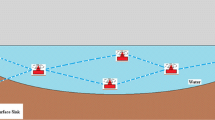Abstract
Non-Conventional media viz. underground and underwater based wireless sensor networks witness many applications such as habitat, mining, pipeline monitoring, etc. In this paper, the concept of a 3-Dimensional (3D) multi-layer transceiver coil structure is proposed. The performance is analyzed in terms of power received and the maximum achievable communication range. The effect of three N-Conv media, viz. seawater, freshwater, and dry soil is investigated for each transceiver coil configuration. Additionally, a 3D multi-layer coil-based Magnetic Induction waveguide structure is incorporated to improve the communication range, which enhances the straight-line communication coverage. Delaunay triangulation and centroid methods are used for optimal relay coil placement. Besides, the 3D-waveguides are deployed in a tree-based topology which provides broad-view communication coverage.















Similar content being viewed by others
References
Karl, H., and Willig, A. (2007). Protocols and architectures for wireless sensor networks. John Wiley & Sons.
Tambe, S., Kumar, V., & Bhusari, R. (2018). Magnetic induction based cluster optimization in non-conventional wsns: a cross layer approach. AEU-International Journal of Electronics and Communications, 93, 53–62.
Kumar, V., Bhusari, R., Dhok, S. B., Prakash, A., Tripathi, R., & Tiwari, S. (2018). Design of magnetic induction based energy-efficient wsns for nonconventional media using multilayer transmitter-enabled novel energy model. IEEE Systems Journal, 99, 1–12.
Giliberto, M., Arena, F., & Pau, G. (2019). A fuzzy-based solution for optimized management of energy consumption in e-bikes. J. Wirel. Mob. Networks Ubiquitous Comput. Dependable Appl., 10(3), 45–64.
Trubia, S., Severino, A., Curto, S., Arena, F., & Pau, G. (2020). On brt spread around the world: analysis of some particular cities. Infrastructures, 5(10), 88.
Akyildiz, I. F., Wang, P., & Sun, Z. (2015). Realizing underwater communication through magnetic induction. IEEE Communications Magazine, 53(11), 42–48.
Sharma, A. K., Yadav, S., Dandu, S. N., Kumar, V., Sengupta, J., Dhok, S. B., & Kumar, S. (2017). Magnetic induction-based non-conventional media communications: a review. IEEE Sensors Journal, 17(4), 926–940.
Ahmed, N., Zheng, Y. R., & Pommerenke, D. (2016). Multi-coil mi based mac protocol for wireless sensor networks, in OCEANS. IEEE MTS/IEEE Monterey, 2016, 1–4.
Sandeep, D., & Kumar, V. (2017). Review on clustering, coverage and connectivity in underwater wireless sensor networks: a communication techniques perspective. IEEE Access, 5(11–11), 199.
Yadav, S., & Kumar, V. (2017). Optimal clustering in underwater wireless sensor networks: acoustic, em and fso communication compliant technique. IEEE Access, 5, 761–776.
Sun, I. F. A. Z. (2009). Underwater wireless communication using magnetic induction,” In: IEEE ICC proceedings, 2009, 1–5.
Sun, Z., & Akyildiz, I. F. (2010). Magnetic induction communications for wireless underground sensor networks. IEEE Transactions on Antennas and Propagation, 58(7), 2426–2435.
Kisseleff, S., Akyildiz, I. F., & Gerstacker, W. (2013). “Interference polarization in magnetic induction based wireless underground sensor networks. In: IEEE 24th International Symposium on Personal, Indoor and Mobile Radio Communications (PIMRC Workshops), 2013, 71–75.
Ahmed, N., Zheng, Y. R., & Pommerenke, D. (2015). Theoretical modeling of multi-coil channels in near field magneto-inductive communication, In: IEEE 82nd Vehicular Technology Conference (VTC2015-Fall), 2015, 1–5.
Kim, J., Kim, B., Kang, J., & Kim, K. (2017). A novel method for estimating multilayer coil inductance. IEEE Magnetics Letters, 8, 1–4.
Sun, Z., & Akyildiz, I. F. (2013). Optimal deployment for magnetic induction-based wireless networks in challenged environments. IEEE Transactions on Wireless Communications, 12(3), 996–1005.
Jiang, P., Wang, X., & Jiang, L. (2015). Node deployment algorithm based on connected tree for underwater sensor networks. Sensors, 15(7), 16763–16785.
Akkaya, K., & Newell, A. (2009). Self-deployment of sensors for maximized coverage in underwater acoustic sensor networks. Computer Communications, 32(7–10), 1233–1244.
Kisseleff, S., Gerstacker, W., Schober, R., Sun, Z., & Akyildiz, I. F., (2013). Channel capacity of magnetic induction based wireless underground sensor networks under practical constraints,” In: IEEE Wireless Communications and Networking Conference (WCNC). IEEE, 2013, 2603–2608.
Jing, H. C., & Wang, Y. E. (2008). Capacity performance of an inductively coupled near field communication system, In. IEEE Antennas and Propagation Society International Symposium, 2008, 1–4.
Chen, B., & Pompili, D. (2014). Reliable geocasting for random-access underwater acoustic sensor networks. Ad Hoc Networks, 21, 134–146.
Lu, X., Wang, P., Niyato, D., Kim, D. I., & Han, Z. (2016). Wireless charging technologies: fundamentals, standards, and network applications. IEEE Communications Surveys & Tutorials, 18(2), 1413–1452.
Prasanna, A. L., Kumar, V., & Dhok, S. B. (2019). Cooperative communication and energy-harvesting-enabled energy-efficient design of mi-based clustered nonconventional wsns. IEEE Systems Journal, 14(2), 2293–2302.
Acknowledgements
The work was carried out under project (ECR/2016/001351) granted by ECR-SERB, Government of India. The authors also acknowledge the generosity of D. N. Sandeep and Laxmi Prasanna for their valuable time spent and inputs in this work.
Author information
Authors and Affiliations
Corresponding author
Additional information
Publisher's Note
Springer Nature remains neutral with regard to jurisdictional claims in published maps and institutional affiliations.
Rights and permissions
About this article
Cite this article
Kumar, V., Yadav, S., Sharma, A. et al. 3D-multilayer magneto-inductive transceiver coil structure and optimal placement of relays for non-conventional media. Wireless Netw 28, 2115–2129 (2022). https://doi.org/10.1007/s11276-022-02949-3
Accepted:
Published:
Issue Date:
DOI: https://doi.org/10.1007/s11276-022-02949-3




